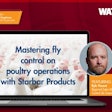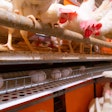
A better understanding of the poultry microbiome can yield better results for integrators and poultry growers.
In a WATT Poultry Chat interview, Dr. Jean De Oliveira, an animal science research manager with Cargill, explains how its Galleon tool can help poultry producers analyze the microbiome to improve production.
Austin Alonzo: Jean, why is it important to understand the poultry microbiome?
Jean De Oliveira: As you can imagine, we have thousands of microbes in the poultry gut and they are very well connected to everything that happens to that bird. And a lot of what we do in practice has been based on just guessing what's going on in that environment. So we're looking into ways to actually bring into practice. So we can routinely analyze this and use actual data to produce insights that can be converted into practical actions to be used in the field.
Austin Alonzo: I understand that you have a microbiome analysis platform, why was that was generated?
Jean De Oliveira: Well, we started working on that already in 2009. And the idea was to really bring into practical use in routine microbiom data for decisions on a daily life and poultry production. And for that, we are shaping this tool over the years to be as easy as possible to decide to the user at the same time, that will bring the most useful information for the decision that we're doing on the daily basis. And with that, we created this tool that we call Galleon. And we are very happy with the success it has on bringing that information to life for the poultry producers. And that as it's being used, we can have decisions made based on actual data.
Austin Alonzo: What can microbiome intelligence do?
Jean De Oliveira: What we learned is that as you're trying to use the microbial information in practice, that we needed to do more than just producing just data analysis and just results of microbes are either increasing or decreasing. What we actually wanted to do is to link the information between the microbes and the practical issues that we have in the farm, just like the use of certain ingredients to lower the feed cost, or to solve problems related to some foodborne pathogens or even linked performance. And for that, what we learned is that we needed more than just running statistics, but we combined this with artificial intelligence models. And with that combination, we got a lot further understanding what the microbiome is doing, and also how to transform it to insights for practical application.
Austin Alonzo: So tell me more about Galleon, your microbiome intelligence analysis tool.
Jean De Oliveira: Yeah, so this tool, as I mentioned, was really designed to bring to life and for routine use in the commercial conditions. And that included things like having a very easy collection protocol that was non invasive. And that we could do it without requiring extra cold temperatures for collection and transport. And that what we actually delivered to whoever is asking the questions, is basically options of how they can bring that into practice. And that's what this tool is all about.
Austin Alonzo: What are the benefits of using this tool?
Jean De Oliveira: So the benefits is that includes the fact that you can now base your decisions on the actual data. You can follow up in the flocks that come after that, what has actually happened to the microbes, you can adjust it based on what you see the situations and what you have seen as you modulate the microbiome to direction that we actually want into this closer to the normal development and the safety. We actually also improve performance in the response to feed programs and even additives.
Austin Alonzo: What can users expect from this service?
Jean De Olivera: We can adjust the feed formulation, look at ingredients, we can look at nutritional levels. We can also tie this to adjust the best additive program and test how efficient they are in the current situation and especially the monitoring burdens to look ahead of time of issues before they become something that is not manageable.
Austin Alonzo: Excellent. Well, where can people learn more?
Jean De Olivera: If you want to learn more, we have a website that you can visit for more information. You also can contact your local Cargill representative, who can also help you.















